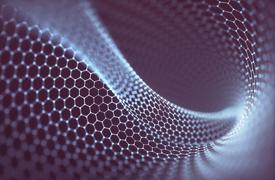

01/25/2021

© KTSDESIGN/SCIENCEPHOTOLIBRARY
Bending graphene on a nanoscale maintains some of the excellent electrical properties of flat graphene while giving others a boost, an AIMR-led team has shown1. By providing engineers with another parameter to work with — namely the radius of curvature — this discovery could lead to novel devices based on three-dimensional (3D) graphene.
Graphene, a one-atom-thick honeycomb array of carbon atoms, exhibits many desirable properties, including high electrical and thermal conductivities and a high electron mobility. These properties make it attractive for a wide range of applications. However, graphene’s flat, sheet-like structure is a problem because large areas are needed for devices, making it difficult to fabricate compact devices.
One way to overcome this problem is to fabricate 3D nanostructures of graphene, since this enables large areas of graphene to be packed into tiny volumes. But this gives rise to another hurdle: the packing often deteriorates the properties of graphene by introducing defects and disrupting the crystalline structure. Until now, it was not clear what role, if any, the radius of curvature plays in this deterioration.
“How the 3D curvature affects the 2D graphene character is a key issue for applications of 3D graphene,” notes Yoichi Tanabe, the first author of the study.
In previous studies, a team led by Mingwei Chen of the AIMR at Tohoku University had made graphene sponges with a bicontinuous and open 3D nanoporous structure. Now, by producing samples of graphene sponges with pore sizes ranging between 25 and 1,000 nanometers, Chen’s team has systematically investigated how the properties of graphene are affected by the radius of curvature.
The researchers discovered that curvature did not alter the electronic states of graphene. Importantly, it preserved the Dirac fermion nature of electrons from which many of graphene’s properties spring. “We showed that graphene with a radius of curvature between 50 and 1,000 nanometers maintained its Dirac fermion character,” says Tanabe.
Furthermore, Chen and the team found that the curvature can be used to tune the electrical transport properties of graphene. “We expect that the properties of graphene can be amplified by nearly 1,000 times in our 3D graphene sponge,” says Tanabe.
The team now intends to explore what effect varying the pseudo-magnetic field, which is induced by curvature, has on graphene. “We found that the pseudo-magnetic field acts a control parameter for curved surfaces of graphene,” says Tanabe. “So next we will try controlling the physical properties unique to 3D curved surfaces by tuning this field.”
This research highlight has been approved by the authors of the original article and all information and data contained within has been provided by said authors.